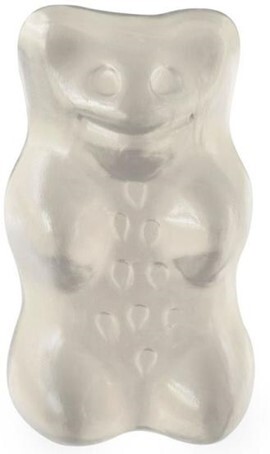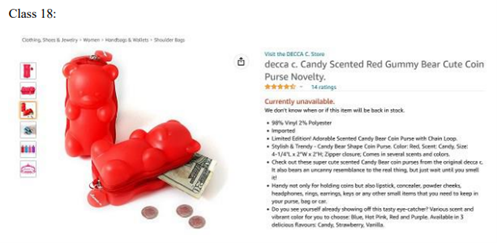
Distinctive gummy bears in the happy world of Haribo! In a further development of EU 3D trade mark law in the food and beverage sector, the EUIPO has held that the image of a gummy bear is sufficiently distinctive to qualify as a trade mark. Our Intellectual Property team considers the decision and its impact for right owners.
In a welcome development for both owners of 3D trade marks and food and beverage producers, the EUIPO Fourth Board of Appeal has recently held that the image of a gummy bear is sufficiently distinctive to qualify for trade mark protection.
Background
Rigo Trading S.A, the Luxembourg-based IP holding company for the Haribo group of companies, in October 2021, designated the EU in its international registration for the figurative mark below.

The application sought protection for a wide range of goods in classes 9, 14, 16, 18, 20, 21, 24, 25, 26, 27 and 28. Interestingly, none of the goods applied for included confectionery or food products.
Initial refusal
The EUIPO refused the application in July 2022. In doing so, it stated that the sign was ineligible for registration under Article 7(1)(b) EUTMR because it was devoid of distinctive character for a large portion of the goods applied for. These included:
- Cases in class 9
- Gemstones in class 14
- Paper in class 16
- Luggage in class 18
- Cushions in class 20
- Cookie jars in class 21
- Textiles in class 24
- Clothing in class 25
- Carpets in class 27, and
- Games in class 28.
In the Examiner’s opinion:
- The appearance of the mark does not depart significantly from the norm or customs of the relevant sector and the consumer normally pays more attention to a label or name of a product than to its shape, packaging or decorative elements.
- The true to life portrayal of a gummy bear or its figurative representation is commonly used for decorative, artistic or aesthetic purposes. Therefore, the sign at issue is a mere variation of various shapes, forms of packaging or decorations commonly used in trade for the goods at issue.
- The EUIPO Examiner made reference to internet extracts dated June 2022 showing the following images, the below being a sample only of the extracts referenced:


In response, Rigo Trading maintained its request for the EU designation by submitting arguments including that the same mark had been registered in the Benelux. Rigo Trading also claimed acquired distinctiveness of the trade mark through use. However, the EUIPO Examiner partially refused protection of the mark in April 2023. The Office consolidated its previous refusal by holding:
- The relevant consumers level of attention for the goods at issue will be average
- It is not against established case-law, nor against current EUIPO practice that even signs consisting of somewhat more elaborated devices can be found non-distinctive, and
- The unique features listed by Rigo Trading will not be perceived as unusual in comparison with other gummy bears on the market.
Rigo Trading appealed.
Board of Appeal decision
The EUIPO Fourth Board of Appeal allowed the appeal and overturned the Examiner’s decision in October 2023. The Board was satisfied that the sign at issue includes distinct characteristics, such as the position of the ears, the nose and the smile of the gummy bear. Together, these elements create a visual impact on the relevant consumers who display an average degree of attention regarding the goods at issue.
The Board also noted that the sign conveys the impression that it consists of a material ie gum and that this is not the usual material the goods at issue are made of. The Board was therefore satisfied that the sign departs significantly from the norm or customs of the sector concerned for the public to perceive it as distinctive for the goods at issue. Moreover, as the sign does not resemble the shape that the goods are most likely to take and in the Board’s view, it had equally not been demonstrated that the sign is a commonplace motif for the goods at issue. On the whole, the Board considered that it must be held that the sign has at least the minimum degree of distinctive character necessary to be protected as a trade mark in the EU.
Comment
The decision will be welcomed by rights holders seeking protection for 3D figurative signs. The decision contains a number of important takeaways including that trade marks can serve a dual purpose as both decorative elements and indications of origin. There are similarities between the Board of Appeal decision and the recent decision of the General Court of the EU in a case involving a confectionery product represented by the shape of a baby’s bottle where it was held that shape did not lack distinctive character given the goods concerned. From these recent decisions and in particular on the question of distinctiveness, brand owners who are considering filing new trade mark applications for 3D marks can take the following points of note:
- In assessing whether the trade mark has any distinctive character, the overall impression it gives must be considered.
- Distinctive character will be assessed firstly, by reference to the goods or services covered by the mark and secondly, by reference to the relevant public’s perception of the mark.
- Where the mark is a figurative sign without any word elements, the perception of the public in the entire EU territory needs to be taken into account.
- The more closely the shape resembles the shape most likely to be taken by the product, the greater the likelihood of the shape being considered to be devoid of any distinctive character by the EUIPO.
For more information and expert legal advice, please contact a member of our award-winning Intellectual Property team.
The content of this article is provided for information purposes only and does not constitute legal or other advice.




